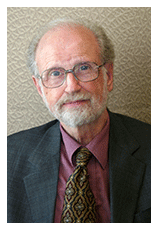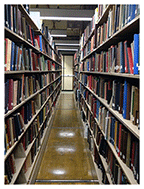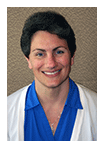Dust. Quiet. White gloves. History. These are a few things people think about when they think about archives and special collections. Like any other library collections, though, archives and special collections are intended to be used. There are two major differences, however. The first is that archives and special collections often cannot be replaced if lost or stolen. Instead, there is simply a gap in the evidence of our history. The second difference is that archives and special collections, by their nature, have enduring value — this means they continue to be relevant for research indefinitely, and therefore need to be preserved so they remain available for use by future generations.
The challenge for archivists comes in balancing the need to safeguard and preserve the unique items in our care, while providing as much access to them as possible. Over the past several months, the Archives and Special Collections (ASC) staff have participated in a variety of activities to increase access to the collections. I thought I’d share a few with you.
 The 6th Sino-American Comparative Literature Symposium brought scholars from around the world to Purdue in May. As part of the Symposium, David Hovde, associate professor and Research and Instruction Librarian, provided a presentation and special viewing of rare books from the Bruce Rogers Collection as well as archival materials showing Purdue’s long history of educating Chinese students. The visiting scholars, many of whom were from China, were particularly interested in a 1950 Purdue PhD dissertation in Physics written by Chia-hsien Teng. Teng, also known as Deng Jiaxian, led a team that developed the atomic bomb. He has been called the “Father of China’s Nuclear Program.” The 6th Sino-American Comparative Literature Symposium brought scholars from around the world to Purdue in May. As part of the Symposium, David Hovde, associate professor and Research and Instruction Librarian, provided a presentation and special viewing of rare books from the Bruce Rogers Collection as well as archival materials showing Purdue’s long history of educating Chinese students. The visiting scholars, many of whom were from China, were particularly interested in a 1950 Purdue PhD dissertation in Physics written by Chia-hsien Teng. Teng, also known as Deng Jiaxian, led a team that developed the atomic bomb. He has been called the “Father of China’s Nuclear Program.”
 Part of the mission of ASC, as the University Archives, is to document the university experience over time. Photos, documents and memorabilia depicting student life enrich our understanding of Purdue history. This spring, an event was held at Windsor Halls to celebrate 79 Years of Windsor Women. Stephanie Schmitz, France A. Córdova Archivist for the Women’s Archives, and Renee Gaarder, graduate assistant, created a display of items relating to the history of women’s residence halls at Purdue. The approximately 150 alumnae who came back to campus for the event were fascinated by the historical photos, postcards, cord skirt, dance cards and related items that brought back fond memories of their Purdue days. Several women donated items to the Susan Bulkeley Butler Women’s Archives as a result. Part of the mission of ASC, as the University Archives, is to document the university experience over time. Photos, documents and memorabilia depicting student life enrich our understanding of Purdue history. This spring, an event was held at Windsor Halls to celebrate 79 Years of Windsor Women. Stephanie Schmitz, France A. Córdova Archivist for the Women’s Archives, and Renee Gaarder, graduate assistant, created a display of items relating to the history of women’s residence halls at Purdue. The approximately 150 alumnae who came back to campus for the event were fascinated by the historical photos, postcards, cord skirt, dance cards and related items that brought back fond memories of their Purdue days. Several women donated items to the Susan Bulkeley Butler Women’s Archives as a result.
Continuing in the theme of traveling collections, items from the George Palmer Putnam Collection of Amelia Earhart Papers recently returned to Purdue from a year-long stint in Washington, D.C. Amelia Earhart’s helmet, smelling salts, prenuptial agreement and a variety of photos and documents were on loan as part of a special exhibit, “One Life: Amelia Earhart,” on display at the Smithsonian National Portrait Gallery. Earhart’s papers are part of the Hilton Flight and Space Exploration Archives, which seeks to document and preserve the contributions of Purdue faculty, staff and alumni to aeronautics and astronautics. Selections from a recent acquisition, the papers of alumni astronaut Jerry Ross, were included in the Purdue University Press’s book, ebook, and app, Spacewalker. Partnering with Digital Programs, ASC created a special online exhibit for the Jerry Ross Papers, including digitization and online access to many films taken by Ross while in space. Tracy Grimm and Neal Harmeyer curated the online exhibit in conjunction with a physical display, and hosted a highly successful Open House for Kids. Within a few hours, the space in ASC was full of excited children and adults, who answered trivia questions about Jerry Ross, viewed the exhibit, and enjoyed popcorn while watching Jerry Ross’s movies.
Although the majority of ASC’s collections are similar to those of Jerry Ross, including historical films, documents, photos and memorabilia, increasingly new acquisitions include born digital material (material that was originally created in electronic form) that needs to be preserved and made accessible. Collections of alumni and faculty papers often include material such as flash drives, CDs, or DVDs of documents, presentations, images and films. As part of a national effort led by the Society of American Archivists, Carly Dearborn has begun surveying the digital collections in ASC. Her work was recently featured, along with surveys from 22 other institutions, as part of the Jump In results posted by the Society of American Archivists. The ultimate goal of digital preservation is not simply to preserve the digital information, but also to provide access to it. This becomes a challenge when dealing with collections of personal papers which often contain a multitude of various copyright holders as well as potential privacy issues.
In addition to inventorying the collections already in ASC’s custody, there is a need to know what historical materials are currently held across campus in the various departments. Lauren White, Project Archivist for University Records, has been methodically surveying the documents, audio-visual and digital records of the various University departments. Her work entails meeting with department heads, faculty, and administrative assistants in each department to identify what records they create and maintain that have historical or research value. She evaluates the size and significance of holdings by each department, the level of use of the records by the department, and any risks to the records caused by their current storage environments or management. So far White has completed six departmental surveys. The end result of this two-year project will be a report on the state of historical records on campus, with priorities set for collections that would benefit from additional preservation and collections that have high research or historical value and should be made more accessible. This will enable the University and the Libraries to plan for improved management of historical documentation, as well as future space needs.
As we look towards the road ahead, ASC has several ambitious goals in the coming year. In collaboration with the Indianapolis Children’s Museum, Tracy Grimm, the Barron Hilton Flight and Space Exploration Archivist, will begin planning for a long-term exhibition at the Children’s Museum dedicated to Purdue astronauts. Elizabeth Wilkinson, Processing and Public Services Archivist, will be working throughout the fall semester with Dr. Kristina Bross’s new Honors course, “Interdisciplinary Approaches to Writing,” to provide students with hands-on experience conducting research using primary sources for writing papers. On the technology front, in partnership with Digital Programs, we will be upgrading CONTENTdm, the software used for e-Archives. The Purdue Libraries has joined MetaArchive to preserve the Libraries collections in e-Archives, e-Pubs, PURR, and Habri Central. Carly Dearborn is leading the team that is preparing the content in these repositories for ingest. We have also signed on to be charter members of the forthcoming ArchivesSpace product for producing online finding aids to archival collections. ArchivesSpace works like an online catalog for archival material, and because it is well indexed by Google and other search engines, researchers worldwide can easily locate unique collections held by Purdue.
Although we certainly have our share of dust, and we take pride in providing a quiet research environment for in-depth study of our collections, Archives and Special Collections is evolving to meet changing research needs in much the same way as the rest of the Libraries. Through partnerships, both on and off campus, digitization of collections, creation of online exhibits and finding aids, experimentation with new publishing models, and creating an infrastructure for preserving and providing access to born digital collections, we are constantly exploring new ways to provide access to our unique and distinctive collections while also protecting and preserving them for the researchers of the future.
|

 The 6th Sino-American Comparative Literature Symposium brought scholars from around the world to Purdue in May. As part of the Symposium, David Hovde, associate professor and Research and Instruction Librarian, provided a presentation and special viewing of rare books from the Bruce Rogers Collection as well as archival materials showing Purdue’s long history of educating Chinese students. The visiting scholars, many of whom were from China, were particularly interested in a 1950 Purdue PhD dissertation in Physics written by Chia-hsien Teng. Teng, also known as Deng Jiaxian, led a team that developed the atomic bomb. He has been called the “Father of China’s Nuclear Program.”
The 6th Sino-American Comparative Literature Symposium brought scholars from around the world to Purdue in May. As part of the Symposium, David Hovde, associate professor and Research and Instruction Librarian, provided a presentation and special viewing of rare books from the Bruce Rogers Collection as well as archival materials showing Purdue’s long history of educating Chinese students. The visiting scholars, many of whom were from China, were particularly interested in a 1950 Purdue PhD dissertation in Physics written by Chia-hsien Teng. Teng, also known as Deng Jiaxian, led a team that developed the atomic bomb. He has been called the “Father of China’s Nuclear Program.” Part of the mission of ASC, as the University Archives, is to document the university experience over time. Photos, documents and memorabilia depicting student life enrich our understanding of Purdue history. This spring, an event was held at Windsor Halls to celebrate 79 Years of Windsor Women. Stephanie Schmitz, France A. Córdova Archivist for the Women’s Archives, and Renee Gaarder, graduate assistant, created a display of items relating to the history of women’s residence halls at Purdue. The approximately 150 alumnae who came back to campus for the event were fascinated by the historical photos, postcards, cord skirt, dance cards and related items that brought back fond memories of their Purdue days. Several women donated items to the Susan Bulkeley Butler Women’s Archives as a result.
Part of the mission of ASC, as the University Archives, is to document the university experience over time. Photos, documents and memorabilia depicting student life enrich our understanding of Purdue history. This spring, an event was held at Windsor Halls to celebrate 79 Years of Windsor Women. Stephanie Schmitz, France A. Córdova Archivist for the Women’s Archives, and Renee Gaarder, graduate assistant, created a display of items relating to the history of women’s residence halls at Purdue. The approximately 150 alumnae who came back to campus for the event were fascinated by the historical photos, postcards, cord skirt, dance cards and related items that brought back fond memories of their Purdue days. Several women donated items to the Susan Bulkeley Butler Women’s Archives as a result.  When I left the Ohio State University Libraries in 1977, a few colleagues chided me about leaving a “great university” to go to a “cow college” in West Lafayette. That was just snobbery on their part, but I do have to admit that in 1978, not only did Purdue shut down at 6 p.m., so did Lafayette and West Lafayette. Well, 35 years and 6 months later, I am still here, and it has been a great professional experience for me. I guess you call that “putting down roots on the farm.”
When I left the Ohio State University Libraries in 1977, a few colleagues chided me about leaving a “great university” to go to a “cow college” in West Lafayette. That was just snobbery on their part, but I do have to admit that in 1978, not only did Purdue shut down at 6 p.m., so did Lafayette and West Lafayette. Well, 35 years and 6 months later, I am still here, and it has been a great professional experience for me. I guess you call that “putting down roots on the farm.” The Future of Print in the Purdue University Libraries
The Future of Print in the Purdue University Libraries Amy Van Epps
Amy Van Epps



